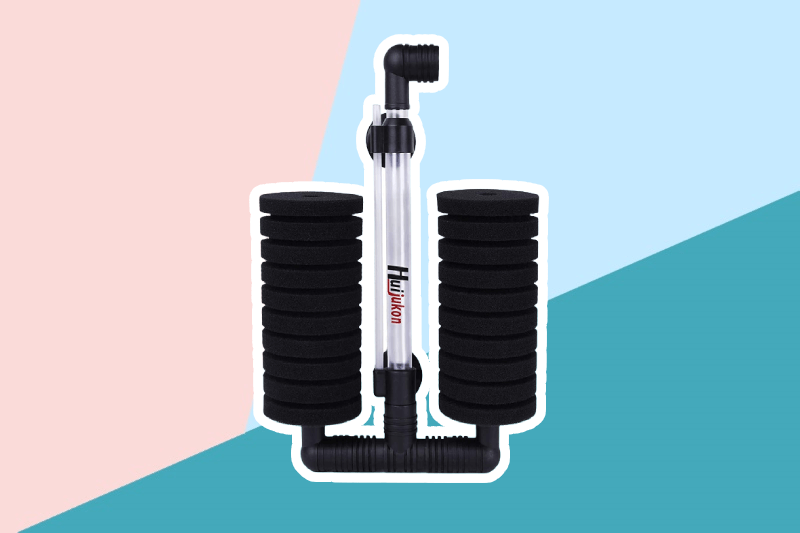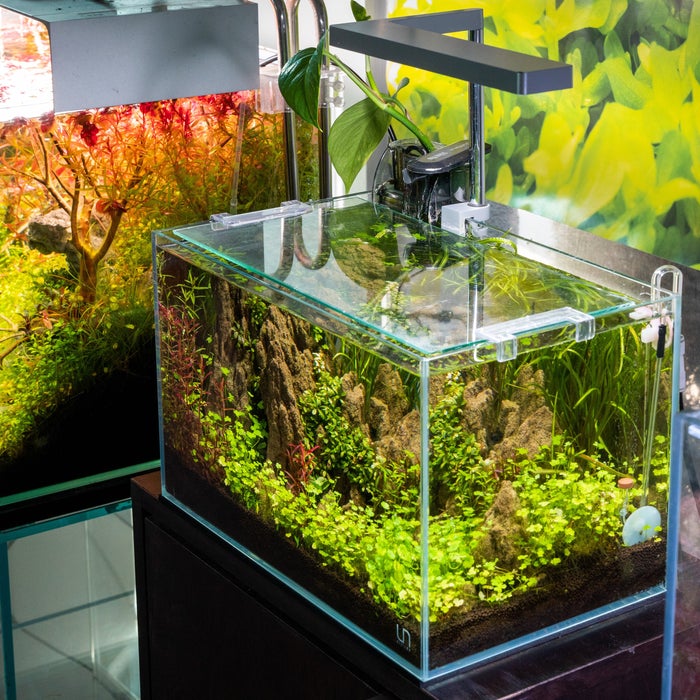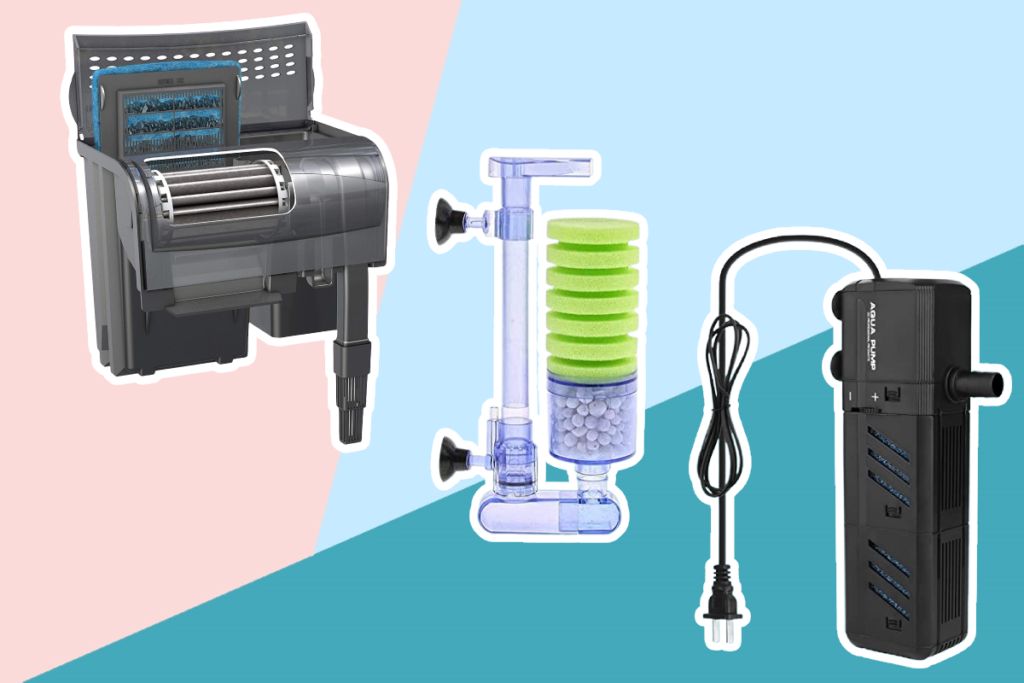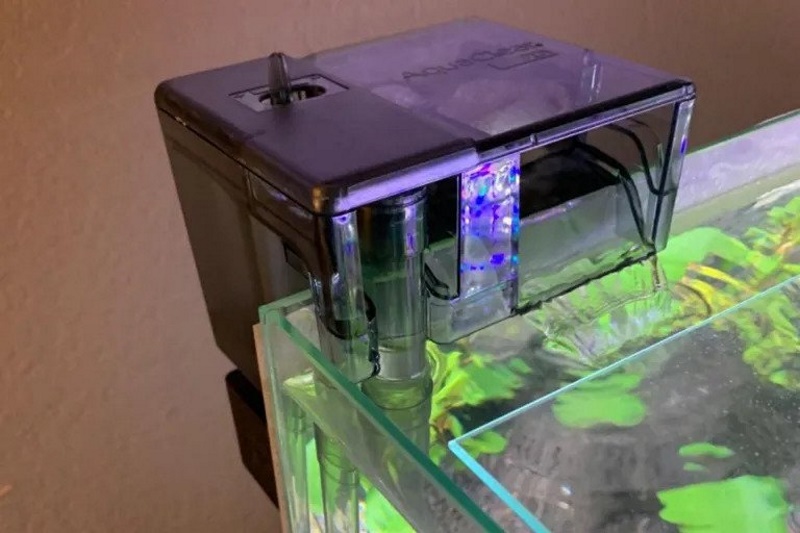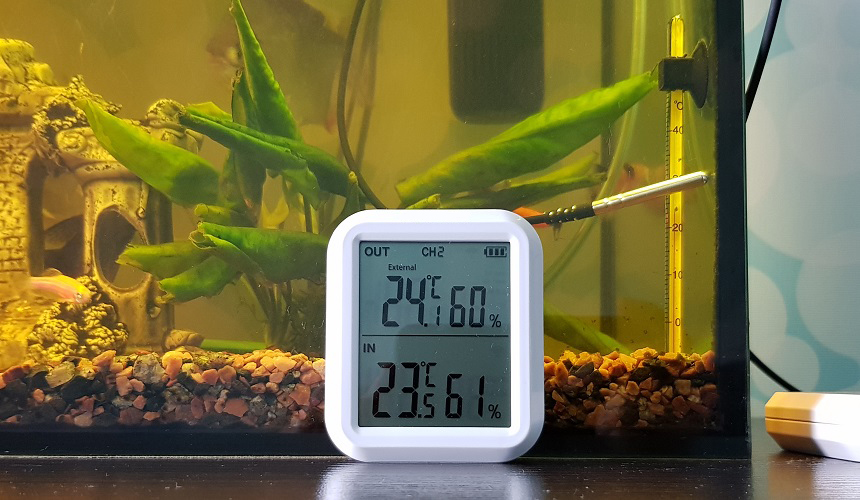

As any Koi keeper knows, having a filter is an absolute must if you want to maintain a clean and healthy pond. A good filtration system will help to keep your water clear and free of debris, while also providing a healthy environment for your fish. In this article, we’ll take a look at the six best koi pond filters on the market, as well as our tips to help you choose the perfect one for your needs.
If you’re searching for the best koi pond filter for your fish, there are a few things to consider. The size of your pond and the number of fish you have will play a huge role in determining the type of filter you need. Don’t forget to check the types of filters available for your koi pond. Cleaning your koi pond filter regularly is also a must to keep your fish healthy. And the last but not least, think about the budget you have to spend on the filter. With all these in mind, we’ve prepared a list of the top 6 pond filters for your beloved koi fish.
More features: sponge-free design, Ultraclean bio balls, electronic bulb-saver, 20-foot cord, 3-year limited warranty
The UltraKlean 2000 Gallon Pond Filter is our Editor’s Choice for the best koi pond filter because it offers superior filtration. It is an excellent option for ponds up to 2000 gallons and a maximum flow rate of 2700 GPH. The sponge-free construction reduces maintenance while also boosting both mechanical and biological filtration. It removes green water with the high-output T5 ultraviolet clarifier, which has a 14 W output. Its Ultraclean Bio Balls efficiently capture dirt and debris. When the filter requires backwashing, a cleaning indicator light will switch on automatically, reminding you to clean up the filter. Plus, it comes with a limited three-year warranty.
The UltraKlean 2000 filter has an upgrade, the UltraKlean 3500 with an identical design. The primary difference between the two filters is that the UltraKlean 3500 has a higher maximum flow rate that is almost twice that of the UltraKlean 3500 and can filter up to 3500 gallons of pond water. It is better suited for large ponds.
More features: bulbs system, bacteriostasis function, clear instruction, automatic cleaning function
If you’re looking for the Best Bio Filter for your koi pond, look no further than the Polar Aurora CPF-250. This powerful filter is suitable for ponds up to 2500 gallons and comes complete with a 13-watt UVC ultraviolet purifier. The bulbs that come with the system help to decrease single-celled algae growth, ensuring your fish a clean and nutritious environment. This filter is constructed of high-quality materials to last a long time and can be placed on the shore or underground.
The Polar Aurora CPF-250 is a pretty solid option when compared to other popular biofilters like the VIVOHOME bio pressure pond filter. They have virtually similar filtering capabilities but the Polar Aurora distinguishes itself as a multiple function tool. If you need a versatile filter that will reduce your pond maintenance duties, go with the Polar Aurora CPF-250. It even has a bulb system that prevents the growth of single-celled algae in the pond.
More features: different filter materials (special filter sponge, Japan matting), blue coarse filter foams and two yellow fine filter foams
The SUNSUN CBF-350 koi pond filter system is the best for its price on the market because it uses a variety of filter media to clean your pond water and keep it looking crystal clear. The SUNSUN CBF-350 has four different stages of filtration (special filter sponge, japan matting), including a section for additional filter media so you can customize the level of filtration for your specific pond needs. This system also has a high flow rate of 2113 GPH, making it suitable for ponds with fish up to 1,500 gallons or ornamental ponds up to 3,000 gallons.
If you don’t have the financial muscle to grab the famous Polar Aurora CPF 250 bio pond filter, you should consider the SunSun Sun CBF 350. You may not get the coolest features like automatic filtering and a bulb system to keep single-cell algae away but your pond will always be clean. At its price point, the SunSun Sun CBF 350 is a worthy buy.
More features: efficient pump, three fountain heads, ceramic biomedia, LED spotlight, two-year guarantee
The Pennington Aquagarden Inpond 5 in 1 is the best filter for those with small ponds that contain 150 to 200 gallons. The filter is combined with an efficient pump that has a flow rate of 192 GPH. The built-in 5-watt UV clarifier light kills green water and algae. The mechanical and biological filtration system does an excellent job of keeping the water clean and healthy. Ceramic biomedia which encourages the proliferation of beneficial bacteria. There are three filters: coarse – to catch dead algae and dirt, medium- to catch small particles, and polymer wool – to polish the water. And it only weighs 2.2 lbs, making it easy to install and maintain. It also has a two-year guarantee.
You can consider the 300-gallon model of the Aquagarden Pennington inpond 5-in-1 filter. It is meant for standard-sized ponds with a fountain or other features and can filter up to 225 gallons of water. Surprisingly, it is within the same price range as the 200-gallon model. The only differences between the two filters are their dimensions and maximum filtering volume.
More features: 1 coarse black filter, 1 fine blue filter, bio-balls, 16 feet power cord
The TotalPond Complete Pond Filter is the best option for medium-sized koi ponds. This filter is perfect for removing debris and improving water quality in ponds up to 1200 gallons. The pump (not included) works with the filter to mechanically clean your pond; the bio-balls biologically promote the growth of beneficial bacteria, and the 9W UV Clarifier cleans the green out of the water. This filter comes with 1 coarse black filter and 1 fine blue filter, but can also work with additional filters for maximum cleaning efficiency.
The TotalPond Complete Pond Filter is just as affordable as the SunSun Sun CBF 350. However, the TotalPond Complete Pond Filter has more cool features. For instance, it comes with a UV clarifier, a rare feature that cleans all the greens in the water. What’s more, it can work with other filters for optimal cleaning efficiency of your pond.
More features: for professional and home use, backwashing, sizes – from 300 to 20,000 gallons
The AST’s Bubble Bead Filter is one of the Best Bead Filters for koi ponds. This filter can handle ponds up to 1000 gallons, and it does an excellent job of mechanical and biological filtration. It effectively removes solids without causing any problems. It is an ideal pond filter for both home and commercial use. The filter includes three primary zones: the filtration bed, washing throat, and expansion chamber. Water enters the filter through a slot pipe at the bottom and travels upward through the bead bed before exiting via a slot discharge pipe at the top. The filter comes with excellent biofiltration, which means there’s also a large area for nitrifying bacteria to grow on.
The BBF XS1000 is similar to all seven BBF XS filters. The only difference is the size of ponds each of them can filter and of course the price. For a standard size pond you can choose either the BBF XS 1000 or the BBF XS 2000. The design and features are all identical. The BBF XS 2000 will require more space though.
Determining the size of a pond is your first step when choosing a koi pond filter. A small pond (<500 gallons) can be effectively filtered with a simple mechanical filter, like a box filter. Larger ponds (>500 gallons) will require a more sophisticated filtration system, like a pressurized canister filter. Otherwise, a too-small filter will be overwhelmed by the waste produced by your fish, while a too-large filter may not provide enough filtration for your needs.
The maximum flow rate of a koi pond filter is an important factor to consider when choosing the right filter for your koi pond. A higher flow rate means that more water can be filtered in a shorter period of time, which is beneficial if you have a lot of koi or other fish in your pond. Conversely, a lower flow rate is better for smaller ponds with fewer fish. It’s important to choose a filter with a flow rate that is appropriate for the size of your pond.
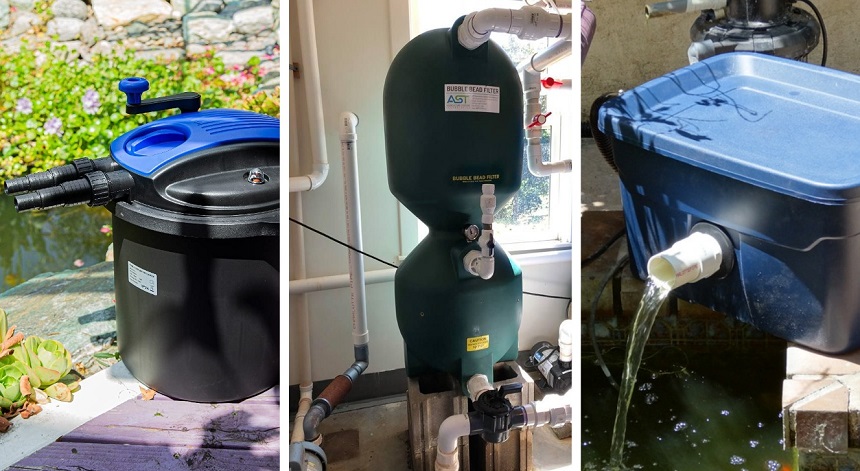
Mechanical filters will physically remove debris from the water. This is done by trapping the waste in a filter media, which can be something as simple as a piece of felt or a more complex system like a multi-stage canister filter.
This type of filter is important in preventing clogs and maintaining water quality.
Mechanical filter media is usually made from a coarse material, such as nylon or polyester.
Mechanical filters need to be cleaned more often than biological filters, but they can be used in conjunction with them to create a more effective filtration system.
A bead filter is a type of mechanical filter that is often used in aquariums and other aquatic systems. The filter consists of a chamber filled with small, spherical beads. These beads are usually made of glass, ceramic, or polymer. Water flows through the chamber and the beads trap particulates and debris. Bead filters like any mechanical filter can be used to remove a variety of different types of contaminants from water.
Bead filters are typically easy to install and maintain. They can be placed inside or outside of a pond, and they do not require frequent cleaning like some other types of filters. Bead filters are also relatively affordable, making them a popular choice for many aquarists.
Another type of mechanical filtration system is a box pond filter that is typically used in ponds. The box filter is designed to remove debris and particulates from the water, while also providing aeration. The box filter consists of a chamber that contains media such as gravel or sand, which traps the debris and particulates. The water then flows through a series of baffles or screens that remove the trapped particles from the water.
Biological filters for ponds usually consist of a media (such as gravel or ceramic beads) that provides a surface for bacteria to grow on. Bio-media can be made from a variety of materials, such as lava rock, ceramic pellets, or plastic.
The media used in aquariums is easily confused with that for ponds. If you’re wondering what type of filter media to use in your aquarium, the best filter media for your aquarium is a good place to start.
The media is usually contained in a chamber that is connected to the pump and filtration system. Water is pumped through the chamber, where it comes into contact with the bacteria-laden media. As the water passes through the media, the bacteria break down harmful waste products, such as ammonia and nitrites.
These filters are usually more effective at cleaning the water than mechanical filters, but they can take longer to “mature” (i.e., develop a large enough population of beneficial bacteria).
Biological filters do not need to be cleaned as often as mechanical filters, but they should be checked periodically to make sure they are functioning properly.
Ultraviolet (UV) light is commonly used in koi ponds to help control algae growth. UV light works by causing the DNA of algae cells (and other aquatic plants) to mutate, which prevents the cells from reproducing. This can help to keep your pond water clearer and reduce the amount of maintenance required.
The amount of filtration a pond needs depends on the type of filter you have, as well as the size and stocking density of your pond.
In general, you should invest in a filtration system with twice to four times the filtering capacity as the volume of your pond.
However, if your pond has a large number of koi or is in direct sunlight for most of the day, you may need a more powerful filter to keep the water clean and clear. In addition, if your koi are particularly large or produce a lot of waste, you may need to upgrade to a larger filter or add additional filtration to your system.
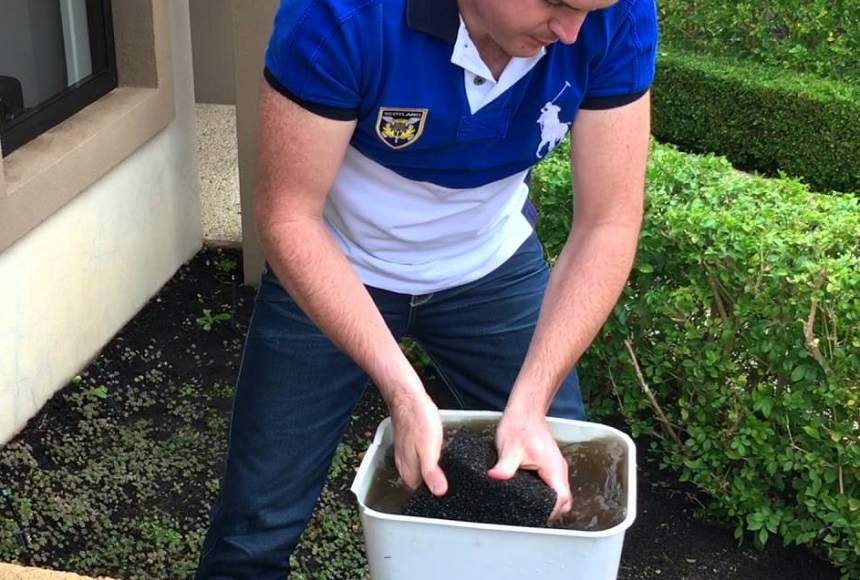
Koi pond filters are not self-cleaning, but they are easy to maintain with regular cleaning. The frequency of cleaning will depend on the size of the pond, the number of fish, and the type of filtration system. Backwashing is available on a few of them, which is excellent for saving you time.
Koi pond filters can cost anywhere from $50 to over $1,000 depending on the type and size of the filter. The most common type of koi pond filter is a biological filter, which uses beneficial bacteria to break down waste in the water. These filters are typically the most affordable option, costing around $50 to $200.
If you have a larger koi pond or one with higher water quality standards, you may need a mechanical and/or UV filtration system in addition to a biological filter. Mechanical filters remove physical debris from the water, while UV filters kill algae and other microorganisms. These types of filters can cost $300 or more.
There are many and varied benefits, but they can be summarized as follows:
The SUNSUN CBF-350 koi pond filter system is the best for its price on the market as it has filters of various types (sponge filter, Japan matting), moreover, you can add your own filter media in a special section You may also adjust the level of filtration to your personal needs. This system has a high flow rate of 2113 GPH, which is perfect for ponds up to 1,500 gallons or ornamental ponds up to 3,000 gallons. However, if you want a UV filter lamp, you should buy it separately.
The Polar Aurora CPF-250 koi pond filter is a top-quality product with biological filtration that is perfect for ponds up to 2500 gallons. It comes with a 13-watt UVC ultraviolet purifier and bulbs that help to decrease single-celled algae growth. This filter is constructed of high-quality materials and can be placed on the shore or underground. It is an excellent choice for those who want the best possible filtration for their koi pond.
The UltraKlean 2000 Gallon Pond Filter is our Editor’s Choice for anyone looking for the best koi pond filters. It offers superior filtration and is perfect for ponds up to 2000 gallons. The high-output T5 ultraviolet clarifier does an excellent job of removing green water, and the Ultraclean Bio Balls are very effective at capturing dirt and debris. The filter also has a cleaning indicator light that reminds you when it needs to be back washed. Plus, it comes with a limited three-year warranty, so you can be sure it’s the best koi pond filter that will last.

